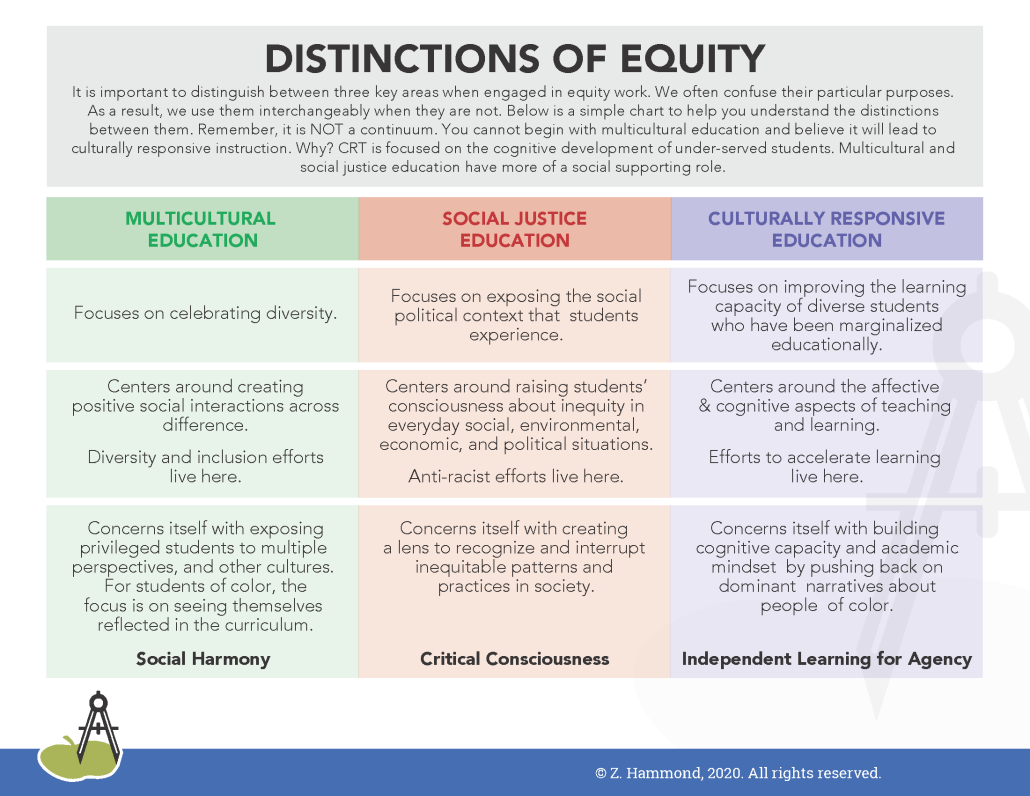Module 4: Culturally Responsive Classroom Practice
Essential Questions
- What is culturally responsive practice?
- How do culturally responsive practices shape the mentorship relationship in an early field experience?
What is Culturally Responsive Classroom Practice?
Defining Culturally Responsive Practice
Culturally Responsive Teaching is a pedagogy that recognizes the importance of including students’ cultural references in all aspects of learning (Ladson-Billings, 1994). This goes beyond awareness, respect, and recognition, but requires teachers to develop knowledge and facultal information about “cultural particularities” (Gay, 2002). Culturally responsive teaching as Dr. Gloria Ladson-Billings framed it is the heart of instructional equity.
Culturally responsive teaching, in regards to the mentor/mentee relationship, encourages a shift from a safe space to a brave space. The idea of a safe vs brave space recognizes that what is “safe” for one individual might not be “safe” for all individuals (Arao & Clemens, 2013). This module offers strategies and practices to develop a brave space and encourages the mentor CT and PST to work together to foster a responsive learning environment.
Relationship to Social Justice Education and Multicultural Education
The following chart (Hammond, 2020) is a useful tool to distinguish between multicultural education, social justice education, and culturally responsive pedagogy.

This chart is used with permission from Hammond for non-commercial, educational use only.
Characteristics of Culturally Responsive Teaching
Culturally responsive teaching explains how various cultural values and experiences shape behaviors. Therefore, it is critical that the mentor CT and PST work together to understand each individual’s backgrounds, perspectives, and values. In this way, both the mentor CT and PST are working to demonstrate cultural and linguistic competence (as defined in module 1).
Culturally responsive teaching is an asset-based approach that focuses on adopting instructional techniques and materials, student-teacher relationships, and a classroom climate that ensures students see themselves and their communities reflected and valued throughout their learning processes and the content (Gay, 2010).
Some characteristics of culturally responsive teaching are:
| Characteristics of Culturally Responsive Teaching | Characteristics Described in Practice |
|---|---|
| Asset-Based Education | Recognizing the strengths of the mentor CT and PST and consider these an asset. |
| Socio-cultural Consciousness | Individual behaviors and thinking patterns from the mentor CT and PST are influenced by identity markers. |
| Self-Reflection | Critical examination to recognize individual bias, attitudes, preferences, and privilege from both the mentor CT and PST. |
| Communication | Fostering a relationship and developing a method for communication that functions for the mentor CT and PST, which honors cultural differences. |
| Care | A genuine desire to want to get to know and build a relationship with the mentor CT or PST, which includes understanding cultural points of reference. |
| Recognition | Consider who is in the school and who isn’t – for some PSTs and mentor CTs, there are very few or no other teachers who are similar to their cultural background or mirror their identity markers. |
